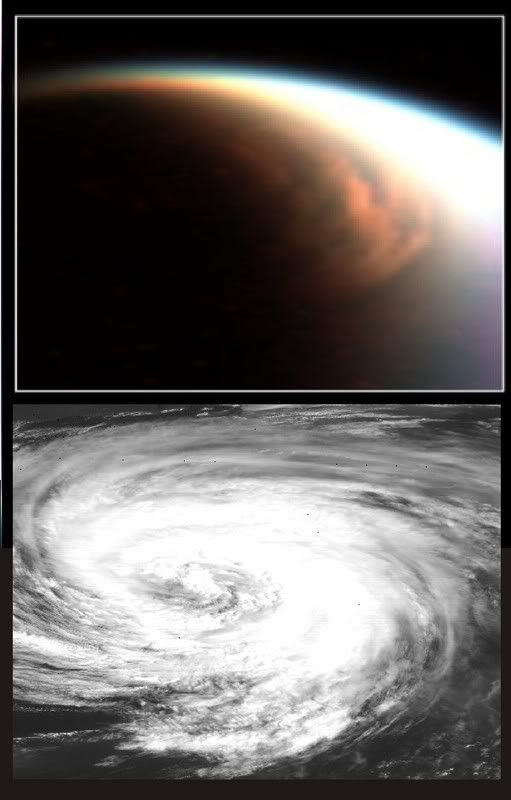
There are many differences between Titan’s atmosphere and Earth’s, in terms of temperature (a couple of hundred degrees lower) and composition (no oxygen, more methane), but the cloud formation recently snapped above Titan’s north pole by Cassini, shown in the top image above, doesn’t look too dissimilar from storms snapped from our own planet’s orbit, as the lower image (source) illustrates. At 2400 km in diameter, it is quite a whopper - it would fill most of the North Atlantic.
It’s not that clouds haven’t been imaged on Titan before; we managed that even before Cassini arrived in Saturnian orbit, and Cassini itself has imaged some before now as well. But those previously observed cloud systems were mainly located around the south pole of Titan; what’s interesting about this one is that it is in the opposite hemisphere, directly above the lakes which have caused so much excitement. This makes it extremely tempting to link the two phenomena. The northern hemisphere of Titan is now entering its spring after a seven-year winter, so evaporation from these lakes in the rising temperatures could easily have contributed to the formation of clouds.
The key question, though, is what happens then: do significant amounts of hydrocarbons rain back out of the atmosphere to complete the “methanological cycle”? Is this precipitation intense enough be actively eroding out the landscapes imaged by the Huygens lander on its descent, and produce standing bodies of hydrocarbons in depressed topography? Or, rather than being refilled from above, are lakes on the surface more to do with hydrocarbon release from either subsurface “methanifers”, or cryovolcanic venting?
Some of these questions are still open. During Huygen’s descent, it measured variations in atmospheric methane concentration and temperature which, when examined in detail, indicated the presence of thin methane clouds capable of generating a persistent light drizzle [1]. Such weather makes the surface of Titan the natural location for any British extraterrestrial colony, but it is not really energetic enough to carve new drainage channels or any other new topography. And although attempts to model Titan’s atmosphere do suggest that strong storms can occur [2], how common or important they are in reality is unclear. Effectively, what we need is more observation time. Just like continuous observations of Mars over several years have revealed changing features which might indicate actively flowing water, if Cassini is able to observe Titan for long enough, we might not only see a few storms but also be able to assess their effect on the landscape.
[1] Tokano et al., 2006. Nature, 442, 432-435, [doi].
[2] Hueso and Sánchez-Lavega, 2006. Nature, 442, 428-431, [doi].
This post was published on Day 1 of the Just Science challenge – a full week of science and only science. You can subscribe to the RSS feed at http://www.justscience.net/?feed=rss2.
All my posts for this week
05 February, 2007
Spot the planetary difference
Posted by
Chris R
at
6:18 pm
![]()
Labels: geology, Just Science, planetary geology
Subscribe to:
Post Comments (Atom)




No comments:
Post a Comment